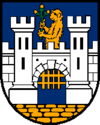Monkey (heraldic animal)
As an exotic animal in heraldry in Europe, the monkey came into the coats of arms late .

In the Middle Ages, like the other exotic camels and elephants , it can be identified in a few coats of arms. Awareness increased with the expeditions. The heraldic animal is said to be cunning and sociable. In other cultures it is assumed to be divine.
The monkeys represented from the large group very common monkey . As a heraldic animal , the monkey is a mean figure and the representation is limited to heraldically looking to the right and sitting on a surface with a raised long tail. In his hand he holds a mirror or a fruit, usually an apple. A collar with a chain is placed around the monkey's neck to prevent it from escaping.
Monkey heads are also known to be placed en face, that is, looking at the viewer. The monkey or the monkey can be found on noble family coats of arms.
The monkey helmet, known from the 16th century, was very similar to the monkey's head. The strong visor of the Spangenhelm led to the name.
See also
- Apenburg
- Dahn (noble family)
- Georg Aff the old man
- Weichs (noble family)
- Balthasar Aff
- Merkatz (noble family)
- Schlabrendorf (noble family)
- Stechow (noble family)
- Guild society to the monkey
